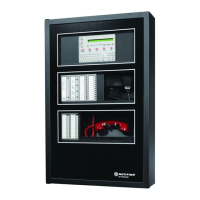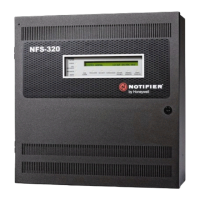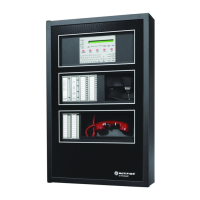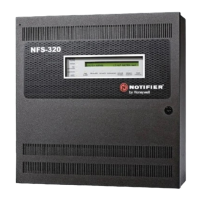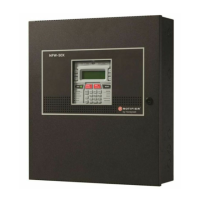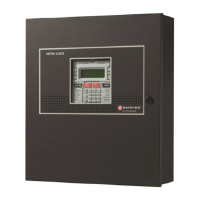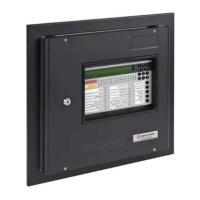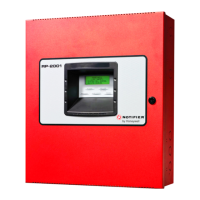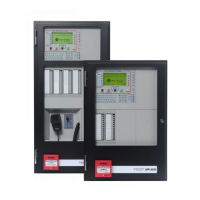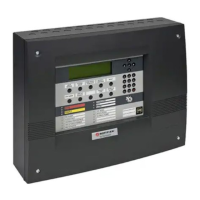16 NFS2-3030 Listing Document — P/N LS10006-051NF-E:F2 5/19/2022
1.10 Fire/Security Applications
General Operation
The NFS2-3030 can be used as a combination Fire/Security system when installed and operated according to the instructions in this section.
For security applications, program one or more monitor module (listed for security applications) with the security-L, system monitor, or area monitor
Type Codes, and wire as shown in Figure 18. Activating these types of modules lights the security LED, and displays a security alarm condition on the
primary display. The panel sounder will sound until you acknowledge the Security alarm. You can also program additional sounders or output devices
to activate with the security alarm initiating device. These type codes are designed to indicate an alarm in one or more of the following situations:
(a) on an open or short circuit
(b) on a ±50% change in resistance value from the End-of-Line resistor value
(c) on loss of communication with the device.
A tamper switch installed in the cabinet door will indicate a door tamper condition whenever the door is open. If the control panel indicates a Security
alarm, you can perform acknowledge, signal silence, and system reset from the control panel.
General Security Requirements
The following security requirements must be met:
• Use an AMPS-24/E power supply
• Shielded cable must be used on all input/output wiring associated with security functions.
• SLC Loop Shielding (refer to the SLC Wiring Manual)
• Security Module I/O Circuit Shielding - terminate the shield at earth ground at the junction box containing the module.
• When employed as a Protected Premises Unit, the control panels cabinet door must be wired with an STS-1 Tamper Switch that is monitored by
the control panel
• If the system has arming and disarming capability, a ring-back signal from the Central Station to the arming location is required. The ring-back
signal informs the Protected Premises Control Panel that the signal to arm/disarm has been received by the Central Station
• An ACM-24AT point must be programmed as ‘disable’ for each security point or zone programmed, doing so allows for a manual bypass before
arming if the point or zone is in trouble
• A duplicate control panel or sufficient spare parts should be made available so that the control panel can be brought back online within 30 minutes
of any failure
• There must be a sufficient number of ACM-24AT’s installed on the control panel to show the status of each zone or point so that each zone or
point can be monitored Any ACM-24AT’s or optional annunciators must be installed inside the protected area
• A single control panel combines a Protected Premises Unit and Receiving Unit as a single unit, as such, it must be located in an area that is
monitored at all times
• The Installer should be familiar with and follow the best practices set forth within ANSI/SIA CP-01 for troubleshooting and reduction in dispatch
calls
• The loss of communication with the monitoring station shall be treated as an alarm condition by monitoring station personnel when the burglar
alarm system is in the armed state and as a trouble condition while the system is disarmed
• Refer to the SLC Wiring Manual (51253) for additional information on required wiring sizes.
There are five software type IDs associated with security operation: ACCESS MONITOR alarm, AREA MONITOR, EQUIP MONITOR, SECURITY-L, and SYS
MONITOR. There is also one software function, Security Delay (SDEL). These software elements are essential to all aspects of security operation,
including Control-By-Event (CBE) programming. Devices with the type IDs A
CCESS MONITOR and EQUIP MONITOR do not automatically display at
the LCD or require state change acknowledgment. State changes in devices with these software types may be output at a printer.
NOTE: The NFS2-3030 is not approved for use in security applications in Canada.
CAUTION: WIRING
DAMAGE CAN RESULT FROM INCORRECT WIRING CONNECTIONS.
NOTE: For Security applications the maximum number of points on a system must be limited to 1000 or less.
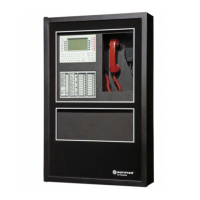
